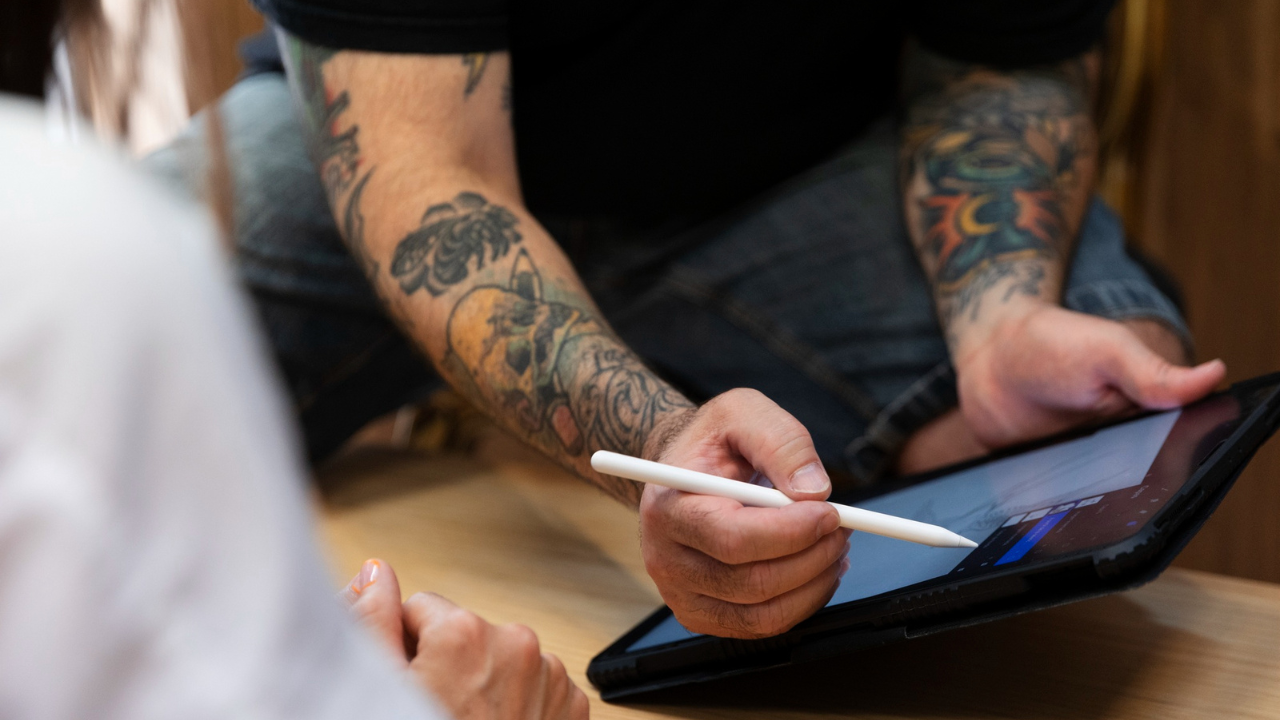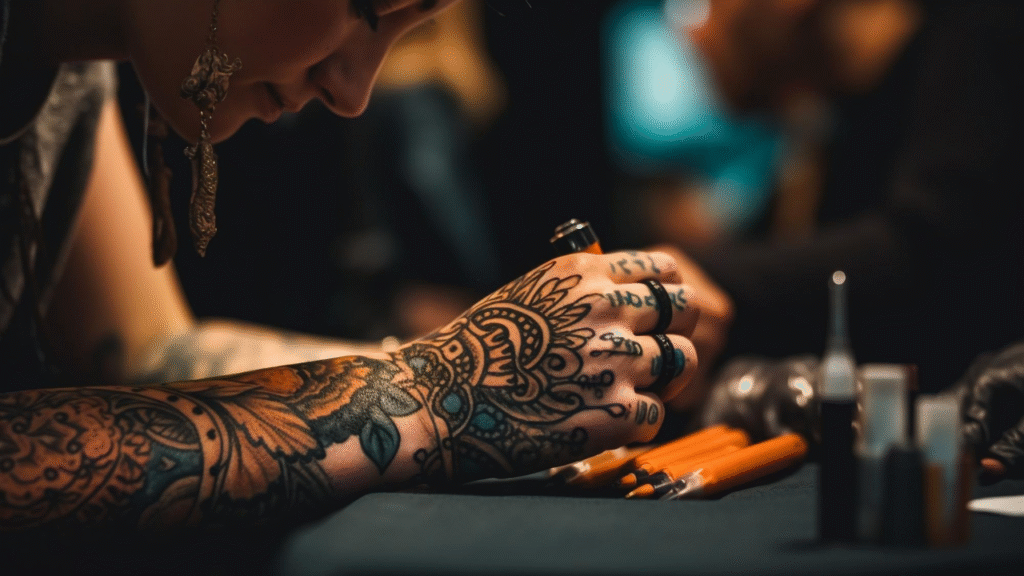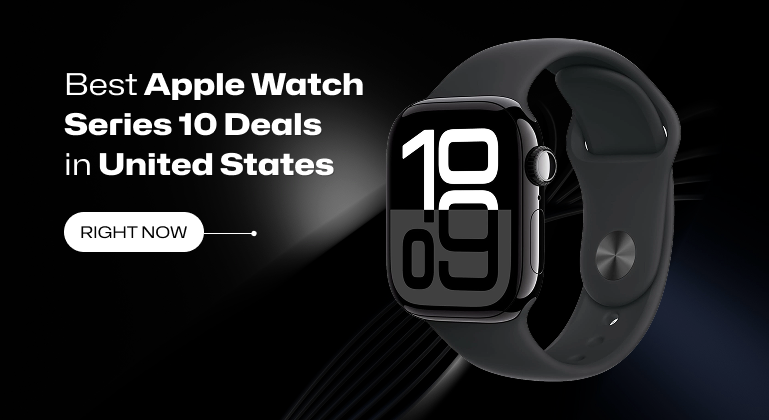
By 2025, the tattoo industry stands to undergo a sea change revolution. Previously, a subculture appearance of body transformation or rebellion, it has become mainstream.
Apart from their mainstreaming into society, however, is the revolution in technology, sustainability, cultural diversity, and safety innovation that is transforming the design, application, and wear of tattoos.
From machine learning technology to green ink and AR sessions, tattoos in 2025 are not merely all about self-expression—smarter choice, greener manufacturing, and worldwide appreciation of art and identity.
Tattoo Trends Innovation
The tattoo machines of 2025 are more intelligent, silent, and ergonomic compared to earlier models.
1. Tattoo Machine And Equipment Advances
The new machines incorporate AI-driven pressure sensors that adjust real-time needle depth and vibration automatically based on the client’s skin type and the complexity of the artwork.
These machines minimize skin trauma to a minimum, offer smoother lines, quicker healing, and less discomfort.
Other than advanced machines, battery-powered and wireless tattoo guns are common these days, which have eliminated most of the wire and allow the artists to travel more freely.
Needle cartridges are adjustable to the last degree as well, so adjustment can be made between sessions without having to reassemble the whole system. All these have made sanitation and mobility better for the artists.
2. 3D Printing Technology For Tattoo Trends
3D printing is revolutionizing tattoo gear. Tailored grips, ink cups, and even life-like 3D-printed synthetic skin models are used to practice and perfect precision.
The models replicate the pliability and texture of human skin, and therefore the apprentices practice without exposing real individuals to it.
Medical tattooing too has come a long way with 3D bio-printing technology, which is now utilized in reconstructive surgery for nipple and eyebrow reconstruction, and in other post-surgical or trauma patients’ anatomy.
3. Digital Design And Editing Software
They no longer have to make an educated guess about the appearance of a tattoo. The artist can show the client how the tattoo would look on the customer’s body using a smartphone or tablet by utilizing augmented reality (AR) design software.
Machine learning and AI-aided apps allow artists to create detailed, customized artwork based on client reviews and sample images.
Apps also provide accessibility to the point that physically disabled tattoo artists can even draw and design using styluses, voice control, or gesture recognition software.
Need to Catch Up On Technological Developments
The tattoo parlors that are not keeping pace with such developments risk falling behind. In an open market, a foray into the newest hardware and cutting-edge applications puts new players at the end of the line.
Demands of today’s patients necessitate innovation—whether through touchless consults and virtual portfolios or expedited recovery and reduced pain.
Staying ahead of technology also enhances health law compliance, promotes efficiency, and provides an improved customer experience.
Sustainability And Environmental-Friendly Practices
Sustainability is no longer hip—it’s just a fact.
1. Utilization Of Eco-Friendly And Biodegradable Tattoo Materials
Tattoo artists in 2025 will use biodegradable ink cups, eco razors, biodegradable gloves, and vegetable ink transfer papers to help make their profession less environmentally draining. Vegan and cruelty-free inks made from organic pigment are safer and greener, too.
Researchers have now started utilizing low-impact cleaning products, reusable barriers, and energy-efficient machinery to lower their impact even more.
Some even use solar power to generate electricity for their research, so the company is totally green.
2. Waste Minimization And Saving Energy Importance
Tattooing used to use a lot of one-time plastic, but those days are behind us. Clients and artists are seeing the daily business trash, and the industry is evolving.
As the studios go green, they’re keeping environmentally conscious clients satisfied, complying with stricter regulations, and greenifying the world.
A revolution of this sort is making the world of tattoos a business- and art-friendly world while also taking care of the world.
Cultural And Artistic Trends

Body tattoo trends have become popular across the globe, and tattoos have also become richer and more cultural.
1. New Cultural Trends And Their Influence On Tattooing
Tattooers of 2025 are creating themes that reflect identity, heritage, gender fluidity, social justice, spirituality, and mental health. Tattoos are becoming richer with these new stories and are turning bodies into texts of life.
Tattoo styles like ancestral displacement, tribal revitalization, sacred geometry, and neotraditional imagery are being sought not for fashion, but with respect for heritage and history.
2. Embracing Cultural Diversity In Tattoo Art
Respect for heritage is becoming front and center. Artists are learning cultural literacy these days, learning to read and honor the symbolism first before even applying it.
Co-practice with cultural historians and native peoples’ consultations is avoiding cultural appropriation.
This shift towards respectful and inclusive tattooing is establishing trust between artist and client and honoring the dignity of sacred arts.
3. Blending Various Art Forms And Styles In Tattooing
With international communication and exchange of digital data, tattoo artists now blend designs from all across the world.
A sleeve will have Japanese irezumi, American traditional, Dotwork, and Māori tribal design—technologically as well as culturally gorgeous.
Tattoo design trends are also moving into multimedia techniques, with tattoo artists using UV-reactive pigments, metallic finishes, and even thermochromic (heat-activated) elements in tattoos that color-change when heated or illuminated.
Health And Safety Innovations
The most crucial part of the tattoo process is aftercare.
1. Innovations In Tattoo Aftercare Products
In 2025, employing smart bandages to track skin temperature, humidity, and healing rate to further optimize healing to be quicker and safer has been adopted.
Additionally, plant balms infused with other substances like CBD, aloe vera, and hyaluronic acid are being used to minimize scabbing, pain, and inflammation.
They are also creating new products for varied constitutions of the ink and of the skin, thus personalizing the healing process.
2. Safer And More Efficient Ink Formulations
US, EU, and Asian governments have established new safety standards for ink. And this has opened the door for heavy-metal-free, non-toxic inks. They are more stable, hypoallergenic, and less likely to cause long-term skin diseases.
Tattoo artists themselves are more willing to disclose ingredients, and some are even voluntarily subjecting themselves to clinical dermatological testing. Putting a focus on safety protects clients and puts the entire profession in the right direction.
3. Non-Invasive Tattoo Removal Methods
Today, in 2025, we are witnessing the introduction of non-invasive technology in the form of enzyme creams that break down particles of ink or ultrasonic wave therapy that vaporize pigments without harming surrounding tissue.
Not only is this technology less painful, but also less of a lifetime commitment. Which is what those who want body painting with no lifetime commitment find appealing.
In 2025, trusted tattoo removal in Manhattan and other major cities will be more advanced and efficient than ever before.
4. Why Safety And Health Should Be So Emphasized In Tattooing
Health guidelines have never been tighter. Tattoo artists are cross-contamination prevention certified, bloodborne pathogen prevention certified, and trained in sterilization techniques.
Shops are regularly inspected, and shops are investing in HEPA air cleaners and UV light sterilization of their own initiative.
Adding health to your tattooing experience makes the industry more credible and dependable to customers, i.e., first-time tattooed customers.
The Tattoo Trends Renaissance Has Arrived
2025 tattoo trends are no longer an art; it’s a showcase of technical skills, environmental practice, cultural awareness, and empowering humans.
From AI machines to AR consultations, green products to cultural consciousness, every aspect of tattooing is being transformed.
These technologies are making more people go for tattooing as a way of expression, healing, identity, and narration.
Tattoo artists are becoming technologists, cultural ambassadors, and health advocates all rolled into one.






